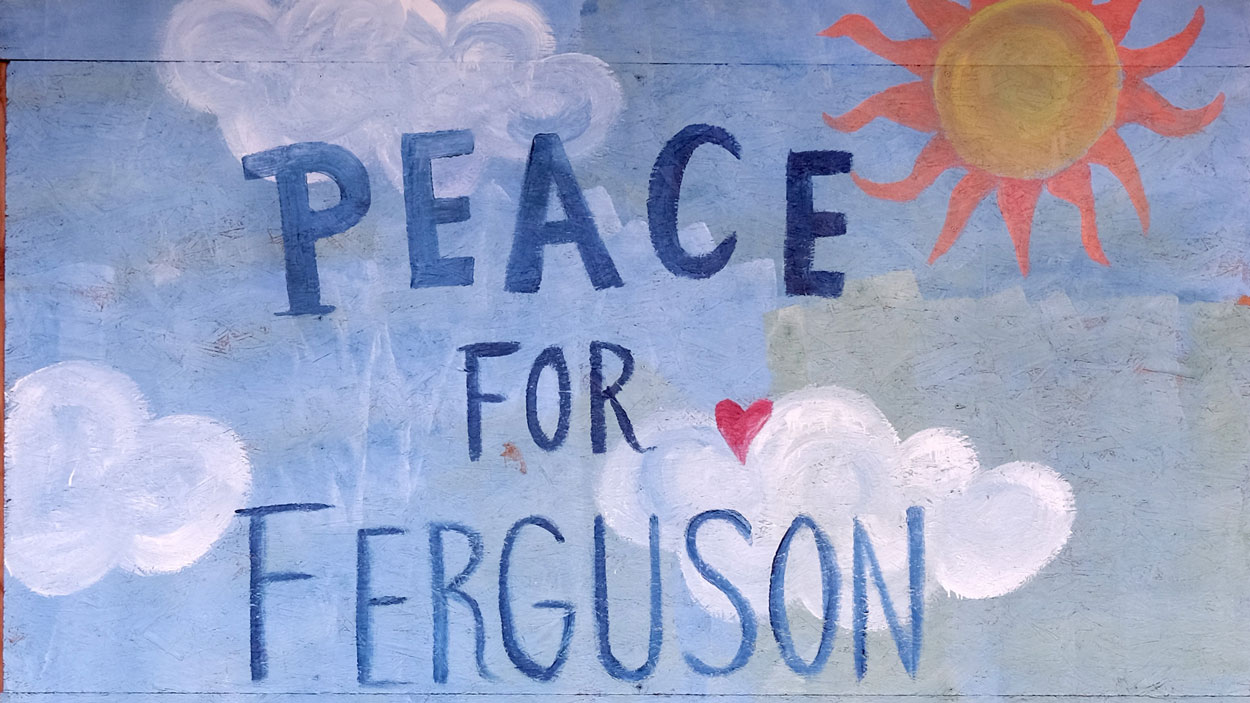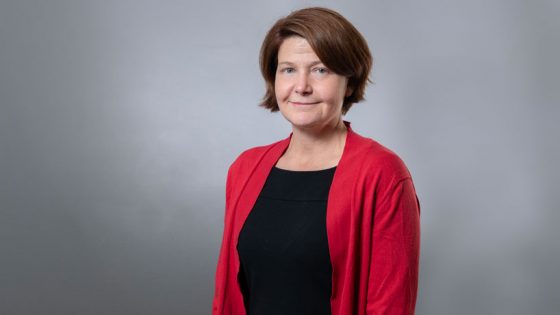
Pieces of artistic expression such as this were painted onto the plywood of boarded-up businesses in Ferguson, Missouri, in the aftermath of civil unrest that followed the 2014 shooting death of teenager Michael Brown. (Photo by August Jennewein)
Lee Slocum, a professor of criminology and criminal justice at the University of Missouri–St. Louis, learned about the civil unrest in Ferguson, Missouri, a decade ago while watching international news from across the ocean.

Lee Slocum, a professor of criminology and criminal justice, has witnessed changes to the criminal justice system and criminal justice research in the decade since the civil unrest in Ferguson, Missouri. (Photo by Derik Holtmann)
At the time, Slocum was on research leave in the Netherlands. From this vantage point, it was a bit surreal to take in images of the protests roiling along West Florissant Avenue, less than four miles from her campus office, in the wake of the killing of teenager Michael Brown by a Ferguson police officer.
“One of the few things we could watch in English on TV was the news,” Slocum recalled. “My husband and I were watching it, and we saw all the civil unrest. It was a different experience for me because I wasn’t on the ground. I heard about it the same way that the rest of the world did.”
She frequently found herself being asked by those around her to share some insight on what was happening. At the moment, she couldn’t have known the extent to which those conversations would continue in the years ahead as the U.S. Department of Justice conducted two investigations – one into the circumstances of Brown’s death and another into the practices of the Ferguson Police Department.
Those investigations would inspire some significant changes to the criminal justice system and for those like Slocum who study it. With the world set to mark the 10th anniversary of Brown’s death this Friday, UMSL Daily spoke to Slocum about the legacy of Ferguson in efforts to reform policing and the impact it has had shaping research.
Obviously, what happened in Ferguson was one major flashpoint in a larger trend that’s occurred over the past decade involving policing, including the death of George Floyd in Minneapolis in 2020. How big an impact has Ferguson had on the national discussion of criminal justice today?
Although there is a long history of police violence in the U.S., Ferguson really was sort of ground zero for those discussions. If Michael Brown had not been killed, it would have started some other place. I think the timing was there. So many people’s lives were being impacted by issues related to the criminal justice system, but Ferguson really did provide that catalyst, and it continues to be brought up in all those conversations. It had a lasting legacy, particularly in areas of police violence.
One of my colleagues, Dave Klinger, noted at that time, there was no national tracking system and no way to know how many people were killed by the police each year. Since that time, there’s been some movement toward understanding that. The FBI did start a reporting system, although so few agencies participate that they don’t release the data. It was only about 40% the last time I checked. But most of the slack has been picked up by research or news organizations that rely on a variety of data sources.
While we’re starting to get a picture of what police violence looks like at the national level, we still don’t have any comprehensive official data that allows us to look at it, and that’s 10 years later. But I think we have made progress in that area.
One of the things the Department of Justice was looking at in the aftermath of Ferguson was police-community relations, which is at the heart of a lot of your research. How closely did you pay attention to the department’s findings?
I was following that pretty closely. The Department of Justice did a very thorough investigation and came out with a report which was over 100 pages long. The catalyst was really the killing of Michael Brown, but the investigation focused on many different aspects of policing and courts in Ferguson.
It discussed many issues, but the main things it documented were policing for profit, which involves funding the government off of revenue generated by policing, and some of the other local discriminatory criminal justice system practices and the harm that these did to residents, particularly in the Black community. A lot of the stories that came out that were most impactful involved people talking about how this one incident of being ticketed or arrested for a relatively minor violation cascaded throughout their life and created problems, leading them to lose their jobs and go into debt.
It also noted that this wasn’t just a Ferguson issue. It was a regional issue.
I had always studied these issues with quantitative data, but these stories made me realize the human side and how something that may seem minor to one person, like a ticket, can really derail the life of another person and have a huge impact on them and their family. One of the things the report did a really good job of highlighting was the human cost of some of regional criminal justice system practices.
Do you think the research questions you’ve been exploring for the last 10 years have been influenced by or shifted because of events that arose during that time?
Definitely. At that time, my research focused on young kids and their contact with the police and how that made them feel. Since then, I’ve looked at it a little bit more holistically, moving beyond the police to what it means to have a safe community and how various communities envision safety in different ways.
There’s been a lot more research on policing and community relations in general and this specific issue of fines and fees.
My former colleague Beth Huebner was part of a national research team that focused on different cities, trying to understand the impact of these court fines and fees on people’s lives and documenting, again, some of these human costs and the inequalities that they perpetuate.
Ferguson led me to have an interest in warrants. It made me recognize that there were so many arrest warrants out for people for failure to pay fines or failure to appear in court. One of the projects we did a few years ago with an organization called the Research Network on Misdemeanor Justice focused on enforcement of low-level offenses, and we worked with the City of St. Louis on that. They gave us access to all their data on arrests and calls for service, and we were able to see the extent to which so many people were being arrested for low-level warrants. We were also able to see the changes in that over time, post-Ferguson and how those numbers had declined.
As a criminologist, has there been more funding available for this kind of research over the past 10 years to support your work?
I think there has been. In general, across the U.S., the National Institute of Justice has put a lot of money into this. There have been a number of philanthropic organizations, both on the left and the right, who have taken a serious interest in criminal justice reform. At the same time, there’s been probably more funding available for the region to address these issues and to study them, although these kinds of things go on in other places as well. If you look in our criminology journals, there are tons of people doing work on police in the community.
Have things changed because of what happened in Ferguson?
Thinking about Ferguson, they’ve been working through their consent decree, which itself details more than 120 pages of reforms. Progress there is ongoing. It started off a little bit slow, but they’ve been making some steady progress recently, particularly around the areas of training and diversifying their police force. They’re almost 50% Black police officers now. They had a lot of turnover initially that stifled their progress, but there are a lot of really dedicated people in that community who want Ferguson to be a better place, a place that is inclusive. They’ve been working really hard, through community groups, through partnerships with the police department, to try to maintain oversight and make sure that things are moving consistently in the right direction.
More broadly, the impact of this has not just been on police violence. It’s been more holistic than just police violence. But people have started to rethink what part of policing is there to promote public safety and where police may not be needed and other organizations or groups might fill in that gap.
One of the biggest changes in the region related to that has to do with how calls are handled that have behavioral health- or mental health-related components. One study showed that around 20% of police use of force cases involve someone who’s in a behavioral health crisis. There’s been a movement toward co-responder models where behavioral health people go on calls with the police. St. Louis County is doing something with diversion at the point of the 911 call. They now have someone embedded in their 911 center who’s available to talk to people experiencing mental health issues, depending on the nature of the call, rather than sending a police officer there. There’s also been a movement to have all police officers trained in crisis intervention so that they’re able to better respond to situations involving people in crisis.
I think there have been people and organizations, and agencies who have continued to make progress in these areas. Laws have been passed. Police are getting better training. There’s more attention also to police officer wellness and the impact that this can have on the work they do. This attention to police violence has been sustained and has not gone away. A lot of the issues are systemic and deep-rooted and are going to take a lot of effort to change, but there are many people doing what they can to enact change.














